The thrill of summer is long gone. The warm air breaks for a cool breeze and the spirit for adventure breaks with it. Hiking boots get thrown to the back of the closet and camping gear gets a special corner in the back of the garage. It's time to hide indoors for another winter.
I see it every year. People's motivation for outdoor sports gets trampled by cold weather. We put outdoor activities in a "summer only" basket and forget about it.
It's no surprise people don't hike as much in the off-season. Winter totally changes the lay of the land. Rocky trails turn into snow beds. Mountains freeze over, and temperatures drop way below the comfort zone.
That’s why hiking is all about location. You don't have to hit the Rockies or the Sierras just to find good hiking ground. The winter-time blues come with an easy cure: Change your destination. Hundreds of trail systems across the U.S. offer beautiful scenery, diverse terrain, mild winters and virtually no snow.
The only way to escape the snow is to fly south for the winter. But don't get the wrong idea. Snow cover doesn't necessarily make a bad hike. Snowshoeing is another great option for winter hiking. For some, snow cover is the attraction.
"Trails are beautiful in the winter," said Lucas St. Clair, co-author of "AMC Guide to Winter Hiking and Camping." "The landscape totally changes from rocky trails to wide open white expanses ... and you get views you'd never get in the summer."
The point is that hiking is a year-round sport. There's always a way to beat the cold and experience the outdoors.
With temperatures dropping and leaves falling, it's prime time to start planning your own winter adventures. Narrowing the search isn't easy, so here are a few top picks for winter hiking destinations.
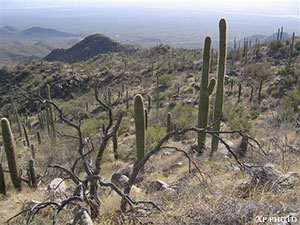
1. Santa Catalina Mountains (Arizona)
Highlights
• Diverse terrain
• Desert routes
• Stunning scenery
• Mild winters
Recommended Trail
• Esperero Trail
Destination
When it comes to hiking in the southwest, the Santa Catalina Mountains are at the top of the list. Hiking in Arizona isn't just about hopping from one desert cactus to the next. This mountain range has a diverse ecosystem, beautiful overlooks and stunning geological formations.
A formation known as The Window, for example, is giant rock archway atop Ventana Canyon that overlooks Tucson. Ventana Canyon is considered by many to be one of the most beautiful locations in the Catalina Mountains.
The Trail
Hiking in this area can be challenging and rewarding. For each beautiful attraction there's an uphill climb. Esperero Trail to Cathedral Rock is revered as one of the most scenic routes in the Catalinas. It passes through areas of desert floor and thick oak forest before reaching its peak at Cathedral Rock.
The trail is nearly 16 miles from the trail head to the summit, but many hikers choose to hike only the first 12 miles to Bridal Veil Falls, a set of waterfalls that cascade down into a large pool below.
Cathedral Rock is only one of many trail options in the Catalina Mountains. The whole area is great for winter hiking. Elevation changes are steep, and desert nights can reach temperatures below freezing. Don't let the idea of hot desert climates fool you. It still gets cold and snow is possibility. So, prepare for anything in the Catalina Mountains.
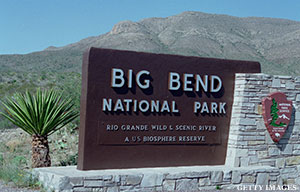
2. Big Bend National Park (Texas)
Highlights
• Extreme Ecological and Geological Diversity
• Warmest winter hike in continental United States
• Shares a border with Mexico
Recommended Trail
• The Outer Mountain Loop
Destination
Big Bend is most famous for its level of diversity. It's often referred to as three parks in one. Its three distinct environments make it unique. The 800,000 acre expanse contains the Rio Grande River, the Chisos Mountains, and the Chihuahuan Desert. That variety alone is worth the trip.
Big Bend's southern geographical location is the very thing that makes it a perfect winter destination. The park shares a border with Mexico making the Chisos Mountains the southernmost range in the nation.
"We have excellent temperatures in the winter," said David Elkowitz, chief of Interpretation for Big Bend National Park. "And we rarely get snow."
According to Elkowitz, 66 degrees is the average high temperature for February. Temperatures like that make it easy to backpack long distances in winter months.
The Trail
Whether you prefer backpacking or day-hiking, the Outer Mountain Loop is one of the best trails the park has to offer.
"The loop is our main backpacking trail," said Elkowitz. "It goes up into the high country mountains. It’s an incredibly diverse trail.”
Stretching 30 miles from start to finish, this signature trail encompasses the full Big Bend experience. Hiking the loop exposes hikers to all three of the park’s ecosystems from one trail.
The Outer Mountain Loop is only intended for winter and spring hiking. Park officials make very clear that it is not for summer use. When it comes to mild winter hikes, it doesn't get much better than a trail intended just for winter use.
If you're looking for a winter hike with spring temperature and variety rocky terrain, check out Big Bend for your winter destination.
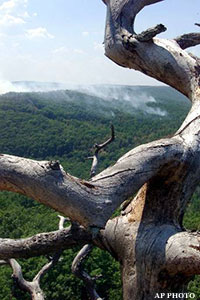
3. Petit Jean State Park (Arkansas)
Highlights
• Trail variety and accessibility
• Lodging Variety
• Mild winters
• Unique geology
Recommended Trail
• Seven Hollows Trail
Destination
Petit Jean is a standalone mountain overlooking the Arkansas River Valley. It's located halfway between the Ozark and Ouachita Mountain ranges. The mountain is home to Petit Jean State Park, the oldest park in the state. It offers a wide variety of scenery, terrain and outdoor activities.
"Petit Jean is a great place to hike during the winter," said BT Jones, park interpreter. "We have over 20 miles of scenic trails in the park."
The longest trail in the park is the Rockefeller Boy Scout Trail. It runs 12 miles from start to finish. There is no camping along the trail, making Petit Jean a day-hiking destination.
The best way to experience Petit Jean State Park in the winter is to get a cabin, warm it up, and plan a series of day hikes. Hike during the day, and keep warm and toasty at night.
There's a great sense of pride and accomplishment in backpacking long trails during the winter, but there's no denying the comfort of a warm cabin at the end of a long, cold hike.
The Trail
Seven Hollows Trail is a four-mile loop that leads through a series of unique geological formations and thick hardwood forests. Rock walls tower on both sides of the first two-mile stretch. Just past a series of small canyons is a side trail that leads to an overhanging rock formation called the Groto.
The Groto marks the half-way point. From there, the trail begins to loop back around to a formation called the Natural Bridge. The natural bridge is actually a tall rock arch that over looks the Seven Hollows Trail. Each unique formation along the trail makes the hike worth the effort.
This trail is only one example of the excellent day-hikes Petit Jean has to offer. The majority of trails in the park are relatively short. An avid hiker could probably experience the park's full trail system in a week or less.
Petit Jean State Park is great for hiking year round. You can pitch a tent if you want, or you can take my advice: Grab a cabin and let this be your comfortable winter hiking destination.
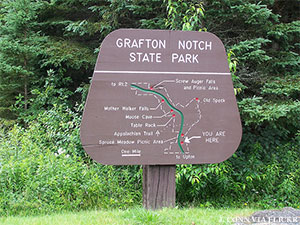
4. Grafton Notch, (Maine)
Highlights
• Snowshoe hiking
• Appalachian Mountains
• Great Trail Accessibility
Recommended Trails
• Old Speck Trail
• Grafton Loop
Destination
Grafton Notch is an excellent hiking destination full of scenic beauty and Appalachian appeal. It becomes a full-fledged winter wonderland once that snow hits the ground. Unlike Big Bend and Petit Jean, there’s nothing mild about Maine during winter.
This Appalachian destination doesn't escape the snow. It owns it. According to Lucas St. Clair, the snow brings Grafton Notch to life.
"It's dark and cold in the base of the notch, and as you climb up you get a bright white, expansive view," he said. "The snow changes the whole landscape."
St. Clair explained how the "excellent snowpack" is an important feature that sets Grafton Notch apart from many other snowshoeing areas.
"The snow there is really stable," he said.
Stable snow means nobody has to worry about an avalanche. You can strap on the snowshoes and breathe a little easier knowing your ground isn’t going anywhere.
The Trail
Old Speck Trail and Grafton Loop are both prominent routes in the area. Old Speck makes up the first 7 miles of Grafton loop, topping at an overlook tower on the summit. It's a challenging trek with drastic elevation gain, but the view from the top is reward enough for any hiker. Those who reach the tower are welcomed by a stretch of white Appalachians filling the horizon as far as the eye can see.
Grafton Loop continues beyond the summit of Old Speck. The full loop is 38 miles from start to finish, making it a perfect white-winter backpacking route. It's a remote, backcountry trail that traverses several peaks, Grafton Notch, Bear River and follows a section of the Appalachian Trail.
Grafton Notch is a rough, cold patch of snowy winter hiking. Those who hike it leave with bragging rights and a story to tell.
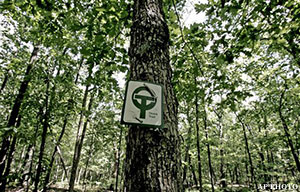
5. Ozark Highlands (Mountain View, Arkansas)
Highlights
• Ozark Mountain culture
• Mild winters
• Lower elevation mountain range
Recommended Trail
• Sylamore Section of Ozark Highlands Trail
The Ozark Mountains are home to some of the nation's most scenic hiking trails, especially in fall and winter months. With popular media attention on the Sierra, Rocky and Appalachian mountain ranges, the hidden beauty of the Ozark Mountains seems to get overlooked. That's like forgetting about a gold mine in your back yard.
The Ozarks get a lot of foot traffic, but it doesn't compare to the busy crowds trekking through those bigger ranges. That means more solitude in the Ozarks.
This slice of American terrain is unique because it offers the full mountain experience at lower elevations and southern climates. No thin air or endless snowfields stand between you and an excellent experience in the Ozark Mountains.
A small country town called Mountain View is the most unique of all the Ozark mountain towns. It's an old-fashion community that embodies that classic highland mountain culture. It's the perfect access point for hiking, fishing, biking, lodging and live folk music. Mountain View is a one-of-a-kind town, and a perfect place to experience the Ozark lifestyle first hand.
The Trail
Mountain View may be an interesting little town, but culture isn’t the only thing that landed it on this winter hiking list. The trail quality is where it really shines.
One of the longest trails in Arkansas is the Ozark Highlands Trail. It stretches 180 miles across the northwest region of the state. This trail is unmatched in winter hiking routes. The scenery is excellent from start to finish, and winter conditions couldn’t be more suitable for trekking through the wilderness.
Thirty-one beautiful miles of the trail pass right through Mountain View. This segment of the Ozark Highlands trail is often referred to as the Sylamore Section. It’s considered one of the most beautiful hikes in Arkansas. The trail follows the Sylamore creek, passing thick forest and tall limestone rock formations along the way. The trail can be hiked straight through or in sections.
It's a perfect blend of culture, quality, climate, terrain and location that makes Mountain View the top pick for winter hiking destinations.
There's no reason to hang those hiking boots up this year. Make the best of winter hiking by choosing the right destination for you.
You could day-hike from the comfort of a warm cabin or embark and an epic backpacking route through miles of snow. Either way, one of these routes is bound to meet your needs.
Popular Stories On ThePostGame:
-- 12 Marathons For 2012
-- The Cost Of Extreme Sports
-- Video: Dad Is Red Sox Fan Who Won't Let His Son Root For The Yankees
-- College Basketball's Dad-Son Coach-Player Duos




